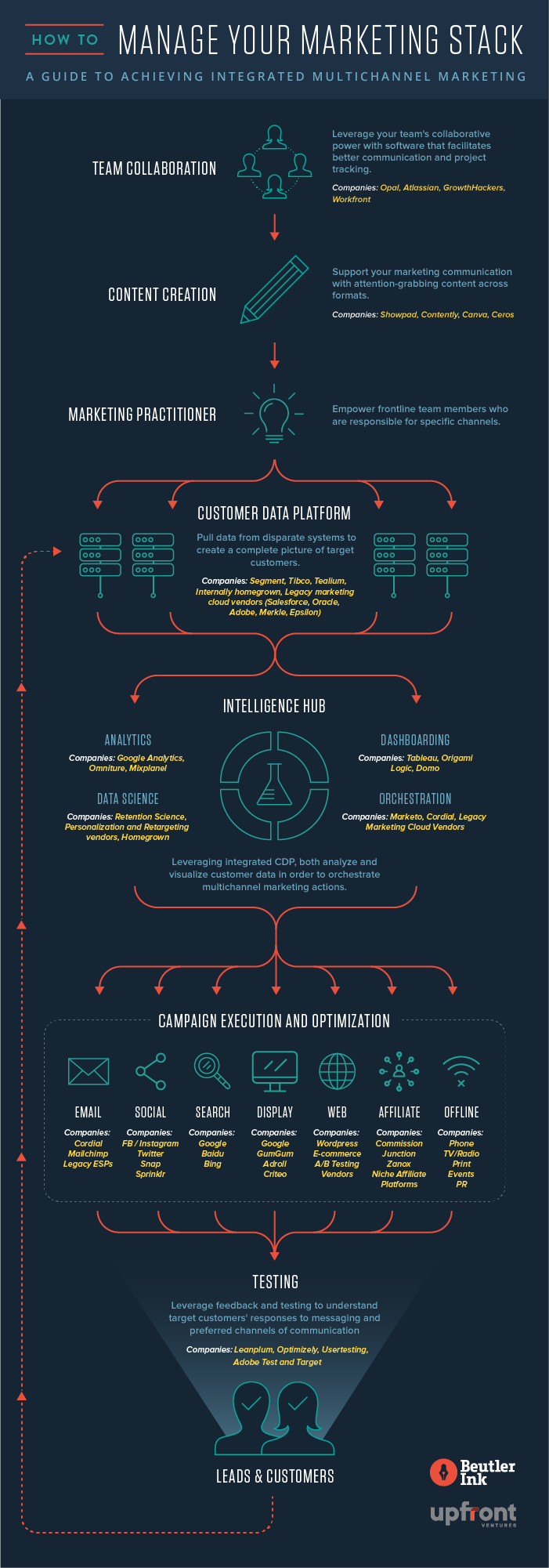Figuring out how to organize your marketing stack is almost like putting together a 1,000 piece blank jigsaw puzzle — impossible.
A Q1 ‘17 survey by CMO Council and RedPoint Global revealed only 3% of respondents felt all of their automation, engagement and deployment tools were fully connected, with data, metrics and insights traveling freely between different technologies.
This stat was staggering to me. Rather than just sit on my hands I’ve put together this infographic, which will help marketers better make sense on how to potentially organize these tools and get closer to achieving cross-channel marketing nirvana.

Organize and focus your team:
You need a team that is organized and led at the level of the New England Patriots. Both your quant marketers and creative teams need systems and processes that help foster trust, harmony, commitment, accountability and orientation towards results (check out The 5 Dysfunctions of Team for more). Marketing specific collaboration tools are taking stabs at addressing these needs and should be incorporated into how you organize your teams.
Know your message:
It’s very easy to get lost in all the process and organization of marketing and totally lose track of the appropriate message you should be communicating to your target customer. Don’t fall into this trap! Put content first as all the effort you put into everything else will be wasted if you fail in crafting the right message. There are a lot of tools that can help you work through the content creation process.
Establish an Intelligence Hub:
Create one centralized view of the customer and apply analytics, data science and orchestration against it so you can enable advanced communication. This is the heart of integrating most of your tools. Create sophisticated automation orchestrating messages within and across channels. Keep in mind your approach should allow for 1 to 1, 1 to many and 1 to all forms of messaging.
At Upfront, we recently invested in Cordial which aims to take this approach allowing marketers to take disparate data sources and create advanced marketing automation campaigns across all the dominant messaging channels in this type of manner. It’s something that’s been incredibly difficult to do with legacy systems until now.
Master the basic channels first:
While there are many exciting new types of marketing campaigns to drive growth, core channels such as email, social, web, search and offline still should be the main centers of focus for marketers. Be careful about getting distracted by next gen tactics like chatbots or VR if you haven’t even figured out the simple channels of reach.
Always be testing:
Invest in tools that test and optimize the performance of existing channels. You should always be searching for incremental lift in every tactic and tool you employ. If you fail in creating a test driven culture it will be very difficult to understand whether some of your new initiatives are really helping or hurting.
Wow the customer:
Focus on the customer experience and strive to make it a magical one. Leverage all data and insights available in order to delight the customer. However, don’t be afraid from time to time to take radical chances by throwing all customer feedback out the door and surprise them with something transformational that they never would expect. Its those types of moments that separate good marketers from great ones.
Keep in mind that this overview is just that — an overview (it’s a lot in some places and over-simplified in others). How you will digest all of this information will, in part, depend upon your expertise. If you’re just starting out, take it slow and don’t get overwhelmed. If you’re an expert, send along some feedback on how this can be improved (there’s an interactive version coming!).
What’s important to remember is that there has never been a more exciting time to be a marketer — and technology is playing a pivotal part in fostering better relationships with customers.
